INTRODUCTION

Whenever i happen to be working on a new router model and i mention it to friends and/or family members there's always at least one person who asks why routers even exist since the modem/routers provided by each Internet Service Provider (ISP) works fine and is more than enough to cover their needs. Well there are two reasons as to why routers are important, first of all the modems or modem/routers provided by ISPs are usually "naked" models that lack several key features and in some cases even components found in their full-fledged brothers. You see when an ISP approaches (or vice versa) an network solutions manufacturer like Huawei, Pirelli and/or ZTE (the three most common ones used by ISPs where i live) striking a good deal (low cost) is the primary goal so what manufacturers usually do is give a regular modem/router to the ISPs but with severely reduced capabilities both in terms of available software and hardware features (these have to do with everything from WiFi, VPN and Security settings up to even available USB and LAN ports). This of course is understandable to a point since many home users may never have real need for a high-end model featuring WiFi AC (802.11ac), USB 3.0 ports and Gigabit Ethernet LAN ports so even a basic unit will do just fine. For more demanding users however even these two hardware features are extremely important (and that's leaving out all the missing software features). So why not just grab a high-end modem/router and be done with it? Well for most households this is actually the optimal choice but if you want to connect multiple local networks together (even on different domains) and provide internet to many more wired and wireless devices turning towards a standalone WiFi router is always a good idea. Roughly 18 months ago TRENDnet released the TEW-827DRU AC2600 StreamBoost MU-MIMO WiFi Router and today finally it's under our "microscope".
TRENDnet is a global provider of award-winning networking and surveillance solutions to small and medium-sized business and home users. Building networking solutions since 1990, TRENDnet enables users to share broadband access, multimedia content and networked peripherals for true anywhere connectivity. TRENDnet's diverse product portfolio includes Wireless, Internet Cameras (IP Cameras), Switches, Power over Ethernet (PoE), Fiber, Gigabit, Home Automation, Network Video Recorders (NVR), Keyboard/Video/Mouse (KVM), Print Servers, Powerline, NAS Media Servers, Multimedia Accessories, and more. To learn more about TRENDnet, please visit www.trendnet.com.
Under the hood of the TRENDnet TEW-827DRU we find the Qualcomm IPQ8064 quad-core network processor (combination of the dual-core Krait CPU @ 1.4GHz and a dual-core 730MHz network subsystem), 512MB RAM, 128MB flash memory, QCA8337 switch and two QCA9980 Wave-2 802.11ac dual-band 4x4 radios (quad-stream). In terms of features the TEW-827DRU supports several performance technologies such as MU-MIMO (multiuser, multiple input, multiple output standard for increased bandwidth efficiency), beamforming (directional signal transmission) and StreamBoost (traffic shaping). Once again although the TEW-827DRU is reported as an AC2600 WiFi router in reality it features simultaneous broadcast of two bands and thus can reach theoretical speeds of 800Mbps on the 2.4GHz (N) band and up to 1733Mbps on the 5GHz (AC) band (both total to 2533Mbps). As for available connectors the TEW-827DRU features two USB 3.0 ports, 4 RJ45 Gigabit Ethernet ports and a single RJ45 Gigabit WAN port.
SPECIFICATIONS AND FEATURES

PACKAGING AND CONTENTS
The TEW-827DRU arrived inside a medium sized box that has a large product picture at the front right over its main features.
Both the quad-stream band and StreamBoost features are partially detailed on the left side.
On the opposite side we find the features and bundle contents lists.
The features list is also placed at the rear in 6 languages right next to two product pictures used to showcase them.
A thick cardboard box is placed inside the package and provides adequate protection for the router and its bundle.
TRENDnet ships the TEW-827DRU with its 4 Antennas, power adapter, RJ45 LAN cable, CD containing the user manual in several languages, registration paper and the user manual.
THE TEW-827DRU
The TEW-827DRU is housed inside a hard plastic enclosure that measures 250mm in length, 180mm in width and 45mm in height.
All of the activity LEDs (power/internet/LAN/WiFi/USB) are placed on a glossy strip placed at the front of the router.
Most of the base of the router is perforated to allow hot air to exit the enclosure.

 Antenna ports are placed on both sides of the router as you can see from the above pictures.
Antenna ports are placed on both sides of the router as you can see from the above pictures.
At the rear of the TEW-827DRU we see two extra Antenna ports, LED on/off button, two USB 3.0 ports, WPS button, 4 RJ45 Gigabit LAN ports, RJ45 Gigabit WAN port, WiFi on/off button, reset button, power on/off button and the DC in.
Four small rubber feet and two wall mounts are placed at the base of the router.
TRENDnet has used 4 high gain Antennas (3dBi for the 2.4GHz band and 4dBi for the 5GHz band) with the TEW-827DRU which of course you can replace with others.
With all the Antennas mounted the TEW-827DRU is not what i'd call small but this is what most modem/routers look like today so we can't complain (of course that will depend a lot on its performance).
SETUP
Just like with previous routers by TRENDnet all you have to do once you connect your system with it is open an internet browser (that will launch the setup wizard).


The setup wizard will ask you about the internet connection configuration and the SSIDs of both bands.
Once you're done with the wizard the router will restart (takes less than a minute).
WEB INTERFACE PART 1

TRENDnet has once again used their typical GUI for the web interface so from the main tab you can check the status of the router (internet/WiFi) and all connected devices.

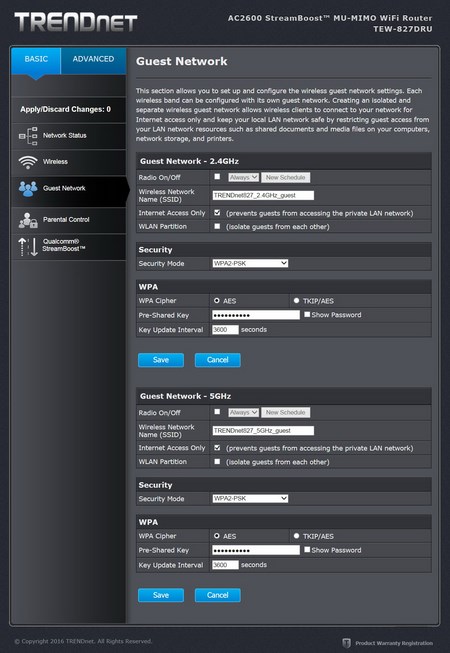
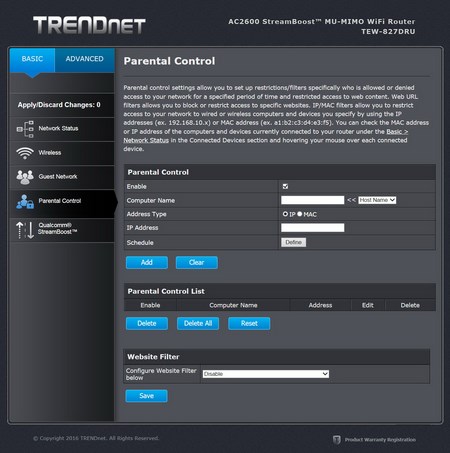

Again the web interface has two columns on the far left basic and advanced. From the basic you can access the wireless settings for both bands, enable/disable the guest wireless network again on both bands (quite useful for businesses that want to provide WiFi to customers without also giving them access to the local network), enable/disable parental controls and also enable/disable and check the status of the StreamBoost feature (strangely enough support for updates ends in roughly a month from now).



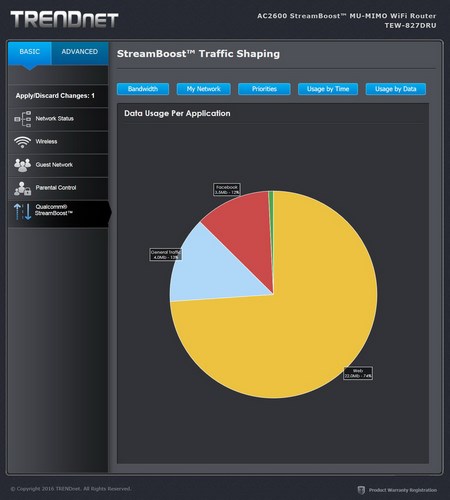
The StreamBoost page not only allows you to check and see what devices are connected to the router but you can also prioritize the ones you want and you can also check internet usage statistics (basically it keeps tabs of what you've been doing with the bandwidth - we were uploading news on Facebook at the time and as you can see it even tracked that).
WEB INTERFACE PART 2




By accessing the advanced menu you gain access to several tabs including the administrator one which allows you to check the status of the router, read system logs, enable/disable UPNP, use WAN ping, capture WAN/LAN packets, import/export settings, set the time and perform various network diagnostics.


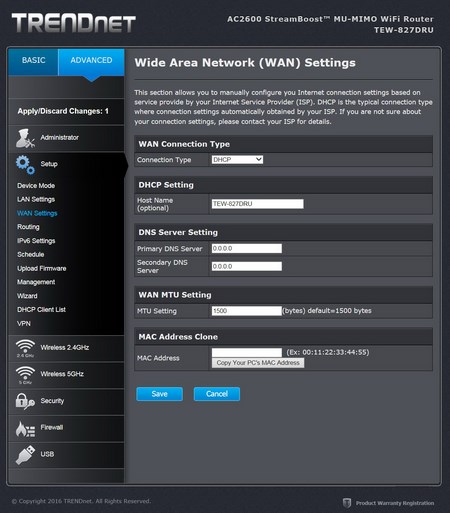
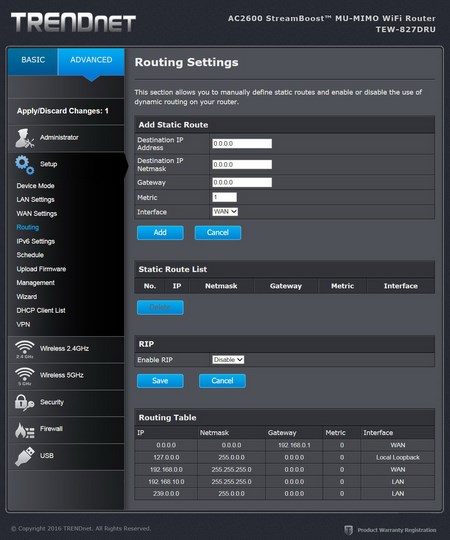



From within the setup page you can change the mode of the router (router or bridge), adjust everything single setting related to LAN and WAN, add static routes, configure IPv6, setup schedule rules, upload new firmware updates, setup user access, enable remote access, initiate the setup wizard, check the DHCP client list and configure the VPN server (allows remote clients to securely connect with your network).




Both WiFi band pages allow the end user to enable/disable WDS (wireless distribution system), access advanced settings like signal strength and MU-MIMO, use the multiple SSIDs feature, configure WPS (Wi-Fi protected setup) and you can also see which devices are currently connected wirelessly to the router.


As clearly stated by its name the security page allows the user to enable/disable access control, add rules to block services and configure the inbound connections filter.






From within the firewall page you can setup the DMZ and Virtual Server options, enable/disable special applications via port triggering, set game rules, configure the application level gateway and finally you can also enable/disable DoS (denial of service) protection.



Finally the USB screen allows you to use a USB connected storage device for media and file sharing or as a BitTorrent download server.
TESTING METHODOLOGY
Since standalone routers can't directly connect to the internet (unless you have a cable connection which we don't) and thus the modem is responsible for internet speeds the only thing that's left is to test and see how much bandwidth they can offer by directly linking two devices with them. So once again we will be using the networking benchmark by Passmark (v.8), the QCheck by Ixia and ATTO 2.47 (since April 2015) to test such devices the same exact way we test Powerline adapters and Modem/Routers. Since we need to test new features and specifications all routers are benchmarked with their highest available wireless standard/band (5GHz in this case). Our systems are outfitted with Kingston HyperX Predator 480GB PCIe SSDs, AC1200 USB 3.0 adapters (we expect new AC1900 ones soon) and CAT7 cables and are placed 15m away from the router with 3 concrete walls between them while each test is repeated a total of 6 times after which the average scores are recorded into our charts. Both systems have Windows 7 Ultimate SP1 installed with all the updates until the 15th of March 2017.
We’ve received several requests by some of you to also measure power consumption when testing modem/routers and although differences are not that great between similar models we decided to do so (average power consumption during tests is placed in our charts). Also again after many requests from April 2017 we will also do our best to measure USB performance of any modem/router or standalone router that gets to our lab with the help of a Samsung T1 250GB Portable SSD.
TEST RESULTS
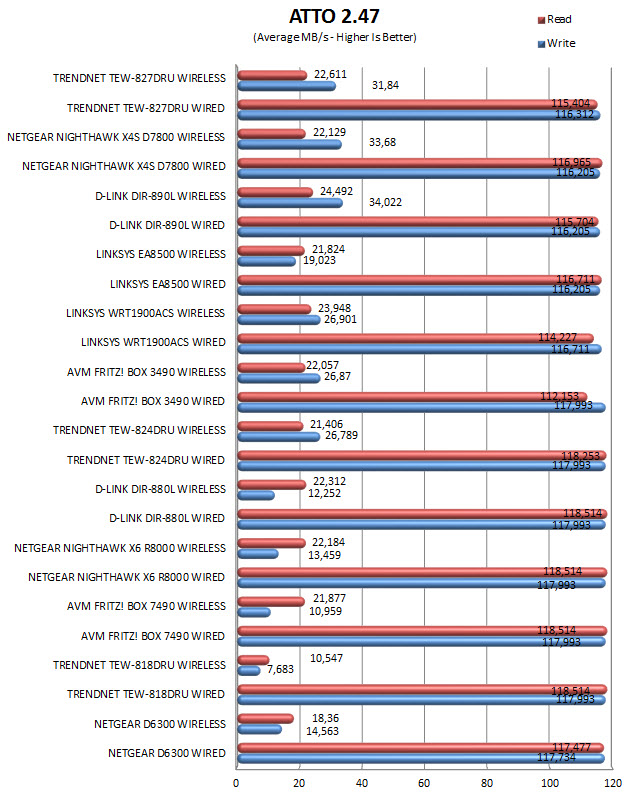



CONCLUSION

The TEW-827DRU AC2600 StreamBoost MU-MIMO WiFi Router by TRENDnet may not be the best looking model currently in the market but it does perform extremely well (even traded blows with the D7800), offers a plethora of available features and is also quite smaller compared to most routers and modem/routers we’ve tested lately (probably not very important to most people but we need to point that out). Not all is perfect however so after coming across some small issues when accessing drives plugged into its USB 3.0 ports (not isolated to this particular model – note that this one of few routers to feature two USB 3.0 ports) and occasionally losing the signal when connected via its 5GHz band (again not something we’ve encountered just with this model – still since our AC1200 USB 3.0 adapters are also by TRENDnet we expect higher compatibility) I found it very strange that TRENDnet has released zero firmware updates since launch. Using the same GUI also left us with mixed feelings since on one hand it’s quite easy to navigate but on the other the dark color theme feels a little bit “heavy”. Overall we feel that the TEW-827DRU delivers on everything one would expect from a good router so all that’s left is to see just how deep you must reach into your pockets to get one.
At launch the TRENDnet TEW-827DRU AC2600 StreamBoost MU-MIMO WiFi Router carried a price tag set at around USD220/230Euros but luckily roughly 18 months later (also thanks to the release of their AC3200 model) that has dropped to USD159.99 inside the USA (Amazon.com) and 204.35Euros inside the EU (Amazon.de). Bottom line you really can’t go wrong with the TEW-827DRU in terms of performance and features so leaving out it’s somewhat “dull” looks (unlike for example the Nighthawk R8000 or the DIR-890L) it really delivers on everything it should and that’s exactly why it gets our Golden Award.
 PROS
PROS
- Size
- Wireless Performance
- AC2600 (Concurrent 802.11n & 802.11ac Bands)
- Features
- Technologies Used (Beamforming / MU-MIMO / StreamBoost)
- 4 Gigabit Ethernet Ports
- 2 USB 3.0 Ports
- LED On/Off Switch
- Price (USA)
CONS
- No Firmware Updates Since Launch
- Design (Compared To Current Router Models)
- Price (EU)

 O-Sense
O-Sense
















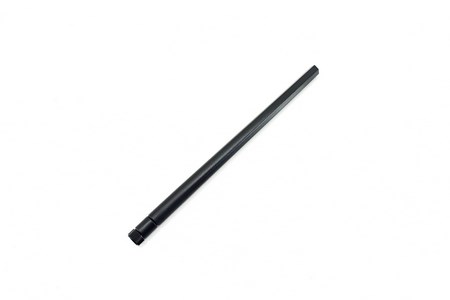





.png)

